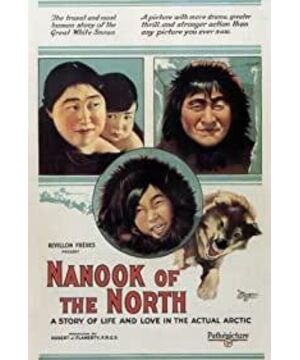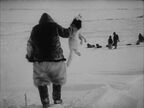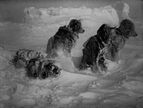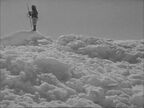The American documentary director Robert Flahardy, known as the "father of documentaries", filmed his first documentary film "Nanuk of the North" in 1922. This movie shows the life of the Nanuk family, the chief of the Inuit near Inujuac in the Hudson Bay in the Arctic Circle in Quebec, Canada, between August 1920 and August 1921. The film fully shows the daily life, lifestyle and the process of building an igloo of the Nanuk family.
The release of "Nanuk in the North" has an epoch-making significance, that is, this film laid the foundation for anthropological social video recording. However, during the filming process, in order to better present the life of the Nanuk family, director Robert Flahadi invited local hunters to perform their own stories. The igloo where the protagonist lives is also dedicated to filming. And built, these man-made traces have caused widespread controversy.
In the concept of many viewers, "recording" is the true reproduction of life without any artistic processing. But for film creators, film is not only a true representation of life, it is also a work of art that is higher than life. If there is no trace of man-made, the artistic value of documentary will be greatly weakened. Although the meaning of film at the beginning of its birth was entertainment, it has developed to the present day by virtue of its own artistic and commercial value.
In fact, from the birth of the first documentary to the current blooming of documentaries, the controversy about documentaries has never stopped, especially the "true" and "false" in the documentary.
Throughout the history of documentary films in the world, it can be found that it has been a long time since the content of documentaries has been filled by means of acting and reproduction in the process of making documentaries. Because equipment and technology have certain limitations and deficiencies at any time, no matter how advanced the equipment is, they cannot travel freely in the past, present and future.
To understand the meaning of "true" and "false" in documentaries, one must start with the difference between documentaries and other film types.
The difference between documentary and feature film:
Style: The story of the documentary is simple, the overall image style is simple and natural, there is no fancy lens language, but the rational processing of the material. Feature films are full of dramatic tension, emphasize story conflicts, and are interesting.
Cycle: The cycle of documentaries is relatively long, and some documentaries take decades to complete shooting. Feature films have a short shooting cycle and focus on storytelling.
Scale: The shooting of documentaries generally does not require too many filmmakers and equipment to join, while the shooting of feature films requires directors, photography, lighting, sound, and drama staff.
Others: Documentaries have less control over the plot and actors, and the uncertainty in the film is greater. Feature films have strict control over plots and actors, and the films are shot completely in accordance with the script.
The difference between documentary and news film:
Style: The documentary focuses on realism, has multiple angles, and has a strong social character. A classic documentary can break the dimensions of time and space. Every time you watch it, you can bring new experiences and feelings to the audience. News films are short and neutral, focusing on events that can arouse general interest, and have strong immediacy.
Cycle: The creative cycle of documentaries is mostly based on the recorded content or perspective, while the creative cycle of news films is based on the time characteristics of the event itself.
Scale: There is not much difference between documentary and news film in scale. It does not require a complete crew, but only some simple equipment and staff to complete the filming.
Others: In a sense, news films can be used as the material of documentaries. News films must have obvious news, and they need to tell the audience the detailed time, location and complete events. Documentary films need a personal perspective, focusing on the connections between things, rather than the things themselves.
The difference between documentary and feature film:
Style: The documentary is an independent whole. It does not need to consider the mainstream ideology, and emphasizes the director's expression and views. The feature film is mainly to meet the country's propaganda needs in politics, economy, culture, education, etc., and its style is mainly based on the mainstream expression mode.
Cycle: The cycle of the feature film is determined according to the needs of the "topic". For example, a historical feature film can be based on a specific person or the change of dynasties, and then determine the time according to the different themes.
Scale: The production of feature films is more complicated. Generally, it is necessary to lay the sound track first, and then match the pictures according to the commentary, but not for documentary films.
Others: Documentaries emphasize independent thinking, and each documentary conveys a deep concern for a certain topic, a certain phenomenon, or a certain person. Feature films just show a certain person, a certain period or a certain event. The former is highly subjective, while the latter focuses on objectivity.
Through the comparison of different types of films, it can be found that the characteristics of the documentary itself are very obvious, and its value is also very high. Take "Nanuk in the North" as an example. Although the filming technique used by the director exceeds the audience's understanding and recognition of the documentary, as the first complete documentary in history, "Nanuk in the North" was released in 1989. Selected in the "National Film Record Book" by the Library of Congress.
In "Nanuk of the North", which ones are true and which are false? What is the meaning and value of "true" and "false"?
The life style of the Nanuk family in "Nanuk in the North" is real, and the details of their lifestyle have a "playing" element. The transactions between the Nanuk family and the whites are part of their lives. Fishing and catching sea lions and walruses are also part of real life. Cooking on stoves and building igloos are real.
During the filming process, in order to better present the artistic value of the film, director Robert Flahadi chose professional hunters to capture sea lions and walruses, and concealed Nanuk’s use of shotguns during hunting. fact. And the igloo was built for this movie. In order to film the activities of the Nanuk family in the igloo, half of the roof of the igloo was also lifted.
But as far as the artistic value of the entire movie is concerned, if there is no “deliberately acting” component, much of the content in this movie would be impossible to complete. Technology, equipment, time, and environment are all irresistible facts. Many problems in the shooting process can be solved through "deliberate play".
Documentary is essentially a form of film. In the process of making the film, the filmmakers gave up excessive control and interference on the content of the film, and weakened the "deliberate play" component in the film. Reflect the "authenticity" of the documentary through the natural expression of truth.
From this point of view, documentaries should focus on "authenticity" rather than "reality". The essence of a documentary is to respect the facts, reflect the fascinating parts of it, and have an obvious director's perspective and point of view.
"True" in documentaries: The so-called "truth" refers to the shooting perspective or viewpoint chosen by the documentary. They have existed or existed, and they are real events or people. If it is an event, the director takes the event as the core and selects related participants and witnesses to form a network. All the content in this "web" is true, and this is the basis of the documentary.
The British John Gleason commented on Flahardy’s films. He said: “It is necessary to grasp and be familiar with the first-hand material in order to better organize the material. Live with the subject for a year or two until the story stands out; the difference between description and drama must be distinguished like Vlahadi... You not only have to photograph natural life, but also creatively interpret nature through the juxtaposition of details Life".
Familiar with the first-hand material, organizing the material, and digging into the material are the "true" part of the documentary, while "the creative interpretation of natural life through the juxtaposition of details" is the "false" part. And to this day, the "authentic and false coexistence" characteristic of documentaries still affects many documentary creators today.
"Pseudo" in documentaries : The so-called "pseudo" refers to "deliberate impersonation" when the equipment or technology cannot be directly filmed or recorded. This approach is not to make the documentary cater to the tastes of the audience, but to solve technical problems and supplement the content. As a branch of film, the core of documentary is still entertainment. Although it emphasizes "authenticity", we know that it is impossible for people to step into two identical rivers at the same time. Therefore, excessive pursuit of the "reality" of documentary, In fact, it is an act of faultfinding.
If a documentary is merely an indiscriminate shooting of daily life, then it becomes a "selfie" in another sense, such as self-made videos on many video websites. After the documentary has rationally structured the real part and the fake part, a new point of view can be interpreted, and its thoughts and emotions can be better expressed. At this time, the "true" and "false" of the documentary are not so important.
Today, documentaries have become one of the most important film genres. Through documentaries, audiences can learn a lot about the little-known world. For example, through "Dolphin Bay" to see the human slaughter of sea elves and dolphins, through "Deep Blue" to show the lives of behemoths in the ocean, to see the harm humans do to them and the destruction of their homes. Learn about the causes and difficulties of environmental protection through "The Truth Can’t Be Ignored".
In short, a documentary is a window for us to understand the world. Putting aside the "truth" and "false" in it, what we see from it is the director's rational record and humanistic care.
View more about Nanook of the North reviews








